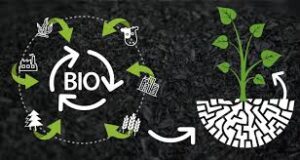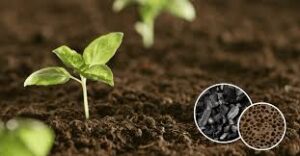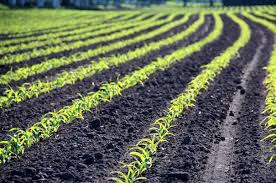In a world increasingly aware of the urgency of environmental, social, and governance (ESG) issues, the search for innovative and sustainable solutions has become an imperative for companies, governments, and civil society. In this scenario, BioChar emerges as an unexpected protagonist, an ancestral material with the potential to revolutionize the way we deal with the challenges of sustainability. Far from being just one type of charcoal, BioChar represents a multifaceted approach to waste management, soil health, food security, and climate change mitigation. Its history dates back to ancient civilizations, which already used rudimentary pyrolysis techniques to enrich the soil and ensure abundant harvests. Today, modern science rediscovers and enhances this ancestral knowledge, revealing the immense potential of BioChar as a powerful tool for building a greener and more resilient future. This article proposes to dive deep into the universe of BioChar, exploring its definition, production processes, benefits, applications, and challenges, with the aim of providing a comprehensive and detailed view of how this material can transform our relationship with the environment and drive the ESG agenda on a global scale.
What is BioChar? Unraveling the Nature of a Transformative Material

To fully understand the impact and relevance of BioChar in the context of sustainability, it is essential to unravel its nature and composition. BioChar, also known as biochar, is a solid, porous, carbon-rich material obtained from the pyrolysis of biomass in an environment with low or no presence of oxygen. Unlike regular charcoal, which is produced for energy purposes and burns quickly releasing carbon into the atmosphere, BioChar is designed to be stable and persist in the soil for hundreds, or even thousands, of years. This stability is crucial to its role in carbon sequestration, as it prevents the carbon contained in biomass from returning to the atmosphere in the form of carbon dioxide (CO2) or methane (CH4), greenhouse gases that contribute significantly to global warming. The raw material for the production of BioChar is vast and diverse, ranging from agricultural and forestry residues, such as coffee husks, sugarcane bagasse, rice straw and wood waste, to sewage sludge and other organic materials.
The choice of biomass and pyrolysis conditions, such as temperature and residence time, directly influence the physicochemical properties of the resulting BioChar, including its surface area, porosity, cation exchange capacity (CEC), and nutrient content. These characteristics, in turn, determine the effectiveness of BioChar in its various applications. The porous structure of BioChar, for example, acts as an ideal habitat for beneficial soil microorganisms, promoting biological activity and nutrient cycling. Additionally, its high adsorption capacity allows it to retain water and nutrients, making them more available to plants and reducing leaching, which is particularly advantageous in sandy or degraded soils. The alkaline nature of many BioChars also contributes to the correction of soil acidity, a common problem in many agricultural regions, improving conditions for crop growth. In short, BioChar is not just a byproduct of biomass burning; It is an engineered material with unique properties that make it a valuable tool for improving soil health, agricultural productivity, and climate change mitigation, representing a link between ancestral practices and modern technological solutions for sustainability.
BioChar Production Processes: From Biomass to Sustainable Charcoal
The transformation of biomass into BioChar is a thermochemical process that occurs under controlled conditions, with pyrolysis being the most common and widely studied method. Pyrolysis is the thermal decomposition of organic materials in the absence or with low concentration of oxygen, at temperatures that usually range from 300 °C to 900 °C. This process results in the production of three main products: BioChar (solid), bio-oil (liquid) and syngas (syngas).
The proportion and characteristics of these products are influenced by several factors, such as the type of biomass used, the pyrolysis temperature, the heating rate, and the residence time of the material in the reactor. There are different types of pyrolysis, each with its own particularities and predominant products. Slow pyrolysis, for example, is characterized by low heating rates and long residence times, favoring the production of BioChar in greater quantities. Rapid pyrolysis, with high heating rates and short residence times, maximizes bio-oil production, while gasification, which involves reacting biomass with a gasifying agent (such as air, steam, or oxygen) at elevated temperatures, focuses on syngas production, with BioChar being a by-product.
Each of these processes has advantages and disadvantages, and the choice of production method depends on the final goals and the raw material available. Slow pyrolysis is often used for the production of high-quality BioChar for agricultural applications, due to its ability to generate a product with higher stability and porosity. The pyrolysis temperature is one of the most critical factors, as it directly affects the composition and properties of BioChar. Higher temperatures generally result in BioChar with higher fixed carbon content, larger surface area, and greater stability, but may reduce the yield of BioChar and alter its nutrient-holding capacity. In addition to pyrolysis, gasification is also a relevant method for the production of BioChar, especially when the main focus is on generating energy from syngas. In these systems, BioChar is a valuable by-product that can be used for a variety of purposes, including soil improvement and carbon sequestration. The integration of BioChar production with renewable energy generation systems, such as the cogeneration of heat and electricity from syngas, represents a promising approach to maximize the efficiency and sustainability of the process.
The selection of raw material also plays a crucial role in the quality of BioChar. Agricultural and forestry waste, such as rice husks, sugarcane bagasse, wood waste, and straw, are commonly used due to their abundance and low cost. The chemical composition of the biomass, including its lignin, cellulose, and hemicellulose content, influences the structure and properties of the resulting BioChar. For example, biomass with high lignin content tends to produce BioChar with higher stability and aromaticity. Continuous research and technological development are driving the optimization of these processes, seeking to increase the efficiency of BioChar production, reduce costs, and enhance its properties to meet the specific demands of different applications. The standardization of production methods and the certification of the quality of BioChar are important steps to ensure the safety and efficacy of the product, promoting its large-scale adoption and contributing to the construction of a more circular and sustainable economy.
Innovative Benefits of BioChar for Soil Health and Agricultural Productivity

BioChar, with its unique physicochemical characteristics, offers an impressive range of benefits for soil health and, consequently, agricultural productivity. Its porous and stable structure acts as a true ‘hotel’ for soil microbial life, providing an ideal environment for the development of beneficial microorganisms such as bacteria and fungi, which play a crucial role in nutrient cycling and promoting plant health. Adding BioChar to the soil can significantly increase water holding capacity, especially in sandy soils that tend to lose water quickly. This is due to BioChar’s high porosity, which allows it to absorb and store large volumes of water, gradually releasing it to plants as needed. This trait is particularly valuable in water-scarce regions or in periods of drought, contributing to the resilience of agricultural systems to climate change.
In addition to water retention, BioChar also improves the availability of nutrients to plants. Its high cation exchange capacity (CEC) allows it to retain essential nutrients such as nitrogen, phosphorus, potassium, calcium, and magnesium, preventing them from being leached into deeper layers of the soil or lost through volatilization. This results in greater efficiency in the use of fertilizers, reducing the need for the application of chemical inputs and minimizing the environmental impact of agriculture. BioChar’s ability to adsorb and retain nutrients also contributes to the reduction of water pollution from fertilizer runoff, protecting aquatic ecosystems and human health. Improved soil structure is another key benefit of BioChar. Its addition can increase soil aggregation, improving aeration and drainage, which favors plant root development and nutrient absorption. In compacted soils, BioChar acts as a decompaction agent, creating pores and channels that facilitate root penetration and air and water circulation. This improvement in soil structure also contributes to the reduction of erosion, protecting the fertile soil layer and preventing land degradation.
Additionally, BioChar can act as a soil acidity corrective, raising the pH and neutralizing the toxicity of elements such as aluminum, which is harmful to plant growth in acidic soils. This pH correction creates a more favorable environment for nutrient uptake and microbial activity, boosting crop growth and productivity. In some cases, BioChar has also demonstrated the ability to reduce the incidence of plant diseases, strengthening the natural resistance of crops and decreasing dependence on pesticides. This property, combined with the other benefits, makes BioChar a promising tool for promoting a more sustainable, resilient, and productive agriculture, in line with the principles of agroecology and food security. In the long term, the continued application of BioChar can lead to a cumulative improvement in soil quality, creating a virtuous cycle of fertility and productivity that benefits both farmers and the environment.
The Crucial Role of BioChar in Carbon Sequestration and Climate Change Mitigation
One of BioChar’s most celebrated attributes, and one that positions it as a cutting-edge solution in the fight against climate change, is its remarkable ability to sequester carbon in a lasting way. Unlike biomass which, when it naturally decomposes or is burned, releases its carbon back into the atmosphere in the form of carbon dioxide (CO2) and other greenhouse gases, the pyrolysis process that generates BioChar transforms this carbon into a highly stable and recalcitrant form. When BioChar is incorporated into the soil, this carbon remains stored for centuries, or even millennia, effectively removing it from the atmosphere and contributing to the reduction of greenhouse gas concentrations. This characteristic makes BioChar a negative emissions technology, that is, it not only avoids emissions, but actively removes CO2 from the atmosphere.
The magnitude of BioChar’s carbon sequestration potential is staggering. Estimates suggest that the global production and application of BioChar could sequester billions of tons of CO2 equivalent per year, playing a significant role in meeting global climate goals. The carbon stability in BioChar is an important differentiator compared to other carbon sequestration strategies. While carbon stored in forests or other forms of soil organic matter can be released back into the atmosphere due to fires, deforestation, or land-use changes, the carbon in BioChar is much more resistant to microbial decomposition and oxidation. This gives a permanence to the kidnapping that is difficult to achieve by other approaches.
In addition to direct carbon sequestration, BioChar contributes to climate change mitigation in other indirect but equally important ways. By improving soil fertility and nutrient use efficiency, BioChar can reduce the need for synthetic fertilizers, whose production and application are energy-intensive and generate significant emissions of greenhouse gases, such as nitrous oxide (N2O), a potent greenhouse gas. BioChar’s ability to reduce N2O and methane (CH4) emissions directly from the soil, by influencing microbial activity and aeration conditions, is also a considerable benefit. In livestock systems, the inclusion of BioChar in animal diet has shown potential to reduce enteric methane emissions, one of the largest contributors to greenhouse gas emissions in agriculture.
BioChar can also be a key component in bioenergy strategies with carbon capture and storage (BECCS). By producing BioChar from biomass, it is possible to generate renewable energy (from bio-oil and syngas) and at the same time sequester the residual carbon in BioChar. This integrated approach offers a dual-purpose solution for producing clean energy and removing carbon from the atmosphere. The economic viability of BioChar production and its large-scale application is a crucial factor for its global adoption. While initial production costs can be challenging, the multiple benefits of BioChar, including increased agricultural productivity, reduced fertilizer requirements, and carbon credit generation, can make this technology economically attractive in the long run. The increasing demand for carbon removal solutions and the appreciation of sustainable agricultural practices are driving the BioChar market, making it an investment opportunity and an essential component for a low-carbon economy. In summary, BioChar transcends the definition of a simple soil conditioner; It establishes itself as a strategic and multifunctional tool in the fight against climate change, offering a promising path for the decarbonization of the economy and the construction of a more sustainable and resilient future.
Multifaceted Applications of BioChar: Beyond Agriculture

Although the application of BioChar in agriculture is the most well-known and studied, its unique properties make it a versatile material with the potential for several other applications in different sectors, contributing to sustainability and the circular economy. The adsorption capacity of BioChar, for example, makes it an excellent material for water and wastewater treatment. Its porous structure and charged surface allow it to remove a wide range of contaminants, including heavy metals, pesticides, pharmaceuticals and dyes, from wastewater and drinking water [1, 16]. In many cases, BioChar can be a more sustainable and lower-cost alternative to conventional activated carbon, which is often used for similar purposes. Research in this area has demonstrated the effectiveness of BioChar in the purification of contaminated water, offering an innovative solution to global challenges of access to clean water and sanitation.
In the construction sector, BioChar has emerged as a promising additive for building materials such as concrete, cement and insulators. Incorporating BioChar can improve the thermal and acoustic properties of these materials, as well as reduce their carbon footprint. By replacing some of the traditional aggregates, BioChar contributes to the production of lighter and more sustainable building materials, which can act as long-term carbon sinks. In addition, BioChar’s low flammability and thermal conductivity make it an interesting material for applications in thermal insulation and fire prevention in buildings. The use of BioChar in construction represents a significant opportunity to decarbonize one of the most carbon-intensive sectors of the global economy.
Another innovative application of BioChar is in the remediation of contaminated soils. Its high adsorption capacity allows it to immobilize organic and inorganic pollutants, such as heavy metals and hydrocarbons, reducing their bioavailability and toxicity to plants and soil organisms [4, 6]. BioChar can be used in areas degraded by industrial activities, mining or environmental disasters, helping to recover soil fertility and restore ecosystems. This application is particularly relevant in a global scenario of increasing soil contamination, offering an effective and environmentally friendly solution for the recovery of degraded areas.
In addition to these applications, BioChar has also been explored in other areas, such as in energy production (as a solid fuel or to enhance biogas production), in livestock (as a feed additive to reduce enteric emissions and improve animal health), and in the manufacture of advanced materials. The versatility of BioChar lies in its intrinsic properties, which can be adapted and optimized through the choice of biomass and production conditions. As research and development advances, new applications for BioChar continue to emerge, cementing its role as a key material for the transition to a more sustainable and circular economy. The ability to turn waste into valuable resources while addressing complex environmental challenges makes BioChar a remarkable example of sustainable innovation.
Case Studies and Data: Proving the Efficacy and Feasibility of BioChar
The growing attention to BioChar is not only based on its theoretical potential, but is solidified by a vast and growing base of case studies and empirical data that prove its efficacy and feasibility in various conditions and applications. Scientific research has consistently demonstrated the benefits of BioChar, from increasing agricultural productivity to improving soil quality and mitigating climate change. In the field of agriculture, numerous field studies and controlled experiments have revealed significant increases in the productivity of various crops after the application of BioChar. For example, research conducted in Brazil, a country with great potential for the production and use of BioChar due to its vast availability of biomass, has shown that the application of BioChar can result in productivity increases of up to 50% in some crops, in addition to a 30% increase in root growth. These results are particularly relevant for tropical agriculture, where soils often have low fertility and high acidity.
A notable study by Embrapa Environment, for example, demonstrated that eucalyptus BioChar, when applied to tropical clay soils, was effective in improving soil fertility, increasing microbial biomass and promoting plant growth. Another impressive fact revealed by this research is that, for each ton of BioChar applied, there was an increase of 500 liters of water available per hectare, a crucial factor for agricultural resilience in scenarios of water scarcity.
The effectiveness of BioChar in retaining nutrients is also widely documented. Studies have proven that BioChar can reduce the leaching of essential nutrients, such as nitrogen and phosphorus, by up to 33% in some crops, such as coffee, decreasing the need for fertilizers and production costs for farmers. This nutrient use efficiency not only optimizes resources but also minimizes the environmental impact associated with fertilizer runoff.
With regard to carbon sequestration, the data are equally promising. BioChar’s ability to stably store carbon in the soil for long periods has been confirmed by laboratory analysis and long-term field studies. The estimate that BioChar can sequester up to 2.2 tons of CO2 equivalent per ton of BioChar produced and applied is a clear indication of its potential as a climate mitigation tool. In addition, the production of BioChar from agricultural and forestry waste offers a solution for the management of this waste, transforming an environmental liability into a valuable asset. The economic viability of BioChar has also been the subject of analysis. While the initial cost of production and application can be challenging, especially for smallholder farmers, the long-term benefits, such as increased productivity, reduced fertilizer costs, and the possibility of generating carbon credits, make BioChar an economically attractive option. The global BioChar market is on the rise, with significant growth projections, which indicates a growing confidence in the commercial and environmental viability of this material.
Case studies in different parts of the world, from farms in Poland to degraded land reclamation projects in Africa, have demonstrated the adaptability and effectiveness of BioChar in different edaphoclimatic and socioeconomic contexts. These practical examples, coupled with robust scientific data, reinforce BioChar’s position as a proven and viable technology to address sustainability challenges, offering tangible solutions for improving soil health, food security, and mitigating climate change on a global scale. Continued research and development of more efficient and affordable production technologies is crucial to further expand BioChar’s reach and positive impact.
Challenges and Limitations: Overcoming Obstacles in BioChar Adoption

Despite the immense potential and proven benefits of BioChar, its large-scale adoption still faces a number of challenges and limitations that need to be addressed if this material is to achieve its full impact on global sustainability. One of the main obstacles lies in production costs and economic viability, especially for small producers. While BioChar can generate significant long-term returns by increasing yields and reducing the need for inputs, the initial investment in pyrolysis equipment and the application of the material can be prohibitive for many farmers. The lack of a robust market and affordable financing mechanisms for the production and commercialization of BioChar also limits its scalability.
Another important challenge is the variability of BioChar’s properties. The quality and effectiveness of BioChar are highly dependent on the raw material used, the pyrolysis conditions (temperature, residence time, heating rate) and the type of soil where it will be applied. This variability can make it difficult to standardize the product and ensure consistent results, which creates uncertainty for users and can limit trust in the technology. The lack of clear guidelines and universally accepted certifications for the production and use of BioChar also contributes to this uncertainty, making it difficult for consumers to distinguish high-quality products from others that may not offer the same benefits.
The logistics of large-scale production and distribution also present challenges. The collection and transport of large volumes of biomass to the pyrolysis plants, as well as the distribution of BioChar to the application areas, can be complex and costly, especially in regions with limited infrastructure. In addition, the production of BioChar can generate gaseous and liquid by-products that, if not properly managed, can cause air and water pollution. The need for more efficient and environmentally friendly pyrolysis technologies, which minimize emissions and maximize energy recovery, is crucial to overcome this challenge.
There are also concerns about sustainability of the raw material. While BioChar is often promoted as a solution for waste utilization, the growing demand for biomass for large-scale BioChar production can lead to competition with other land uses, such as food production, or even deforestation, if there is no careful planning and proper regulation. Ensuring that the biomass used for the production of BioChar comes from sustainable sources and that its production does not compromise food security or biodiversity is fundamental for the credibility and acceptance of the technology.
Finally, awareness and knowledge about BioChar is still limited in many regions. Lack of information and misinformation can make it difficult for farmers, policymakers, and the general public to adopt the technology. The need for education and rural extension programs, which demonstrate the benefits of BioChar and provide guidance on its best practices of use, is essential to overcome this barrier. Overcoming these challenges will require a joint effort by researchers, policymakers, companies, and communities, with investments in research and development, the creation of incentive policies, the standardization and certification of the product, and the promotion of sustainable production and use practices. Only in this way will BioChar be able to reach its transformative potential and contribute significantly to a more sustainable future.
The Future of BioChar: Prospects and Potential for Global Sustainability

BioChar, with its multifaceted ability to address environmental and agricultural challenges, is positioned to play an increasingly prominent role in the global transition to sustainability. The prospects for the future of BioChar are promising, driven by the growing awareness of climate change, the need for more resilient agricultural practices, and the search for innovative solutions for waste management. One of the main trends for the future of BioChar is its integration into regenerative agricultural systems and the circular economy. As agriculture seeks to become more sustainable and less reliant on external inputs, BioChar offers a natural solution to improve soil health, increase productivity, and reduce the carbon footprint of farming operations. Combining BioChar with other regenerative practices, such as no-till, crop rotation, and the use of cover crops, can create synergies that amplify the benefits for the soil and the environment.
The development of more efficient and scalable BioChar production technologies is another key factor for its future. Research and innovation are focused on optimizing pyrolysis processes to maximize BioChar yield and quality, while minimizing production costs and emissions. The modularity of pyrolysis systems, which allows the production of BioChar at different scales, from small rural units to large industrial facilities, will facilitate its adoption in various contexts. In addition, the integration of BioChar production with renewable energy generation, through the cogeneration of heat and electricity from syngas, will make the process even more attractive from an economic and environmental point of view.
Expanding BioChar’s applications beyond agriculture is also an area of great potential. The use of BioChar in water and wastewater treatment, in the remediation of contaminated soils, and as an additive in building materials are examples of how its properties can be exploited to solve a variety of environmental problems. Continued research in these areas is likely to reveal new applications and optimize existing ones, broadening the market and impact of BioChar. The increasing demand for carbon credits and the appreciation of carbon removal solutions will also drive the BioChar market. As companies and governments seek to meet their decarbonization goals, BioChar presents itself as a reliable and verifiable option for long-term carbon sequestration. The creation of robust and transparent carbon markets, along with certification and verification mechanisms, will further encourage the production and use of BioChar.
In Brazil, the potential of BioChar is particularly significant, given the vast availability of biomass and the importance of agribusiness to the economy. The country has the opportunity to become a global leader in the production and application of BioChar, taking advantage of its natural resources and its expertise in tropical agriculture. Research and development initiatives, along with public incentive policies, can accelerate the adoption of BioChar and position Brazil at the forefront of the bioeconomy and sustainability. However, for this future to materialize, it is essential to overcome existing challenges, such as the need for standardization, reducing production costs, and raising awareness of the benefits of BioChar. Collaboration between governments, the private sector, academia, and communities will be essential to create an ecosystem favorable to the development and dissemination of BioChar. With strategic planning and continuous investments, BioChar has the potential to become a fundamental pillar for building a more sustainable, resilient, and prosperous future for all.
BioChar as a Pillar of the Circular Economy and Environmental Resilience
Throughout this article, we have explored the multiple facets of BioChar, from its definition and production processes to its innovative soil health benefits, its crucial role in carbon sequestration, and its multifaceted applications that transcend agriculture. We evidence, through case studies and concrete data, the effectiveness and feasibility of this transformative material, while addressing the challenges and limitations that still need to be overcome for its large-scale adoption. BioChar is not merely a product; It is a concept, a philosophy that aligns perfectly with the principles of the circular economy and environmental resilience. It represents the ability to transform waste into valuable resources, to regenerate degraded soils, to mitigate climate change, and to build more sustainable and efficient production systems.
Its ability to retain water and nutrients, promote soil microbial activity, and reduce the need for chemical fertilizers positions it as an indispensable ally for a more productive and less impactful agriculture. Additionally, its role in long-term carbon sequestration makes it a powerful tool in the fight against global warming, offering a tangible solution for removing CO2 from the atmosphere. BioChar’s applications extend beyond the field, encompassing water treatment, remediation of contaminated soils, and civil construction, demonstrating its versatility and potential to positively impact various sectors of the economy. However, for BioChar to reach its full potential, it is imperative that challenges related to production costs, standardization, logistics, and awareness are tackled collaboratively. Investments in research and development, public incentive policies, the creation of transparent carbon markets, and the dissemination of knowledge are crucial steps to accelerate their adoption.
Brazil, with its vast availability of biomass and its agricultural vocation, has a unique opportunity to lead the BioChar revolution, transforming waste into prosperity and sustainability. By embracing BioChar, we are not just adopting a technology; We are investing in a future where food production is harmonious with environmental preservation, where waste is valued, and where climate resilience is a reality. BioChar is therefore more than a charcoal; It is a symbol of hope and a fundamental pillar for building a greener, prosperous and sustainable future for generations to come. It is proof that by looking to the past and applying modern science, we can find innovative solutions to the most pressing challenges of our time, paving the way for a truly circular economy and a society in balance with nature.
The Complexity of BioChar Structure and Its Implications

The structure of BioChar is remarkably complex and multifaceted, which gives it its unique properties and versatility in diverse applications. On a microscopic level, BioChar is characterized by a highly porous network, with a vast surface area that can range from tens to hundreds of square meters per gram. This porosity is the result of the removal of volatiles during the pyrolysis process, leaving behind a carbonized structure with a myriad of pores of different sizes – from micropores (smaller than 2 nm) to macropores (larger than 50 nm). The distribution and size of these pores are crucial, as they directly influence BioChar’s ability to adsorb water, nutrients, and contaminants, as well as to harbor microbial communities. Micropores, for example, are essential for the adsorption of small molecules and for the protection of microorganisms against predation and desiccation, while macropores facilitate the flow of water and air in the soil.
In addition to porosity, the chemical composition of BioChar’s surface plays a key role in its interactions with soil and organisms. The surface of BioChar is rich in oxygenated functional groups, such as hydroxyl (-OH), carboxyl (-COOH), and carbonyls (C=O), which give the material a surface charge and the ability to interact with ions and organic molecules. These functional groups are responsible for BioChar’s cation exchange capacity (CEC), which is a measure of its ability to retain plant-essential cations such as calcium, magnesium, and potassium. A high CEC in BioChar means that it can act as a reservoir of nutrients, gradually releasing them to plants and reducing leaching losses. The presence of residual minerals, such as silica, calcium, and potassium, from the original biomass, also contributes to the properties of BioChar, acting as nutrient sources for plants and influencing soil pH.
BioChar’s stability in soil is another distinguishing feature that sets it apart from other forms of organic carbon. BioChar’s highly condensed and aromatic structure makes it resistant to microbial degradation, allowing it to persist in the soil for extended periods, which is critical for long-term carbon sequestration. The recalcitrance of BioChar is influenced by the pyrolysis temperature; higher temperatures generally produce a more stable BioChar with a higher fixed carbon content. This stability gives BioChar a crucial role in building carbon stocks in the soil, contributing to climate change mitigation. In-depth understanding of BioChar’s structure and properties is essential to optimize its production and application, ensuring that it is utilized effectively to maximize its environmental and agricultural benefits. Continued research in this area seeks to further unravel the mechanisms by which BioChar interacts with soil and ecosystems, paving the way for new applications and the enhancement of existing ones.
Detailing of Pyrolysis Processes and Their Impacts on BioChar Quality

Pyrolysis, as a core method for BioChar production, is not a monolithic process, but rather a spectrum of approaches that vary in terms of temperature, biomass residence time in the reactor, and heating rate. Each variation results in a BioChar with distinct characteristics, optimized for different applications. Slow pyrolysis, for example, is the most traditional and widely studied method for producing BioChar. It is characterized by moderate temperatures (usually between 300 °C and 600 °C) and long residence times (from hours to days), with slow heating rates. Under these conditions, the biomass gradually decomposes, favoring the formation of a highly porous and stable carbonized structure. BioChar produced by slow pyrolysis tends to have a larger surface area, higher cation exchange capacity, and a higher fixed carbon content, making it ideal for agricultural applications where improving soil fertility and carbon sequestration are the primary objectives. In addition to BioChar, slow pyrolysis also generates bio-oil and syngas, but in smaller proportions compared to other methods.
In contrast, **rapid pyrolysis** operates at higher temperatures (usually between 400 °C and 800 °C), with very short residence times (from seconds to a few minutes) and extremely fast heating rates. The primary goal of rapid pyrolysis is to maximize the production of bio-oil, an energy-dense liquid that can be used as a fuel or feedstock for the chemical industry. BioChar produced by rapid pyrolysis is generally less porous and has a smaller surface area than slow pyrolysis BioChar, but it can still be used in some agricultural and environmental applications. Flash pyrolysis is an even more extreme variation of fast pyrolysis, with millisecond residence times, aiming for maximum bio-oil production.
Gasification is another thermochemical process that can produce BioChar as a byproduct. In this method, biomass is converted into a combustible gas (syngas) through reactions with a gasifying agent (air, oxygen, water vapor, or a mixture of them) at elevated temperatures (usually above 700 °C). BioChar resulting from gasification is often denser and less porous than slow-pyrolysis BioChar, but it still has valuable properties for soil improvement and carbon sequestration. The main advantage of gasification is the production of clean energy from syngas, which makes it an attractive option for electricity and heat generation, with BioChar as a valuable co-product.
The choice of pyrolysis temperature is one of the most critical factors influencing the properties of BioChar. Higher temperatures generally result in a BioChar with higher fixed carbon content, higher aromaticity, and greater stability, which is desirable for long-term carbon sequestration.
However, very high temperatures can reduce the yield of BioChar and alter its porous structure, affecting its water and nutrient retention capacity. The raw material used also plays a crucial role. Biomass with high lignin content, such as wood waste, tends to produce more stable BioChar with higher porosity, while biomass with high cellulose content, such as agricultural waste, can result in BioChar with larger surface area and more reactive functional groups. Continuous research and development is focused on optimizing these processes to produce BioChar with specific properties to meet the demands of different applications, ensuring maximum efficiency and sustainability.
Delving Deeper into the Mechanisms of Action of BioChar in the Soil and Its Impacts on Agricultural Productivity
The complex interaction between BioChar and the soil environment is key to the myriad of benefits it offers to agriculture. Understanding the mechanisms underlying these interactions is critical to optimizing your application and maximizing your potential. One of the most significant aspects is the improvement of soil structure. The addition of BioChar, with its porous structure and particles of varying size, acts as an aggregating agent, promoting the formation of macro and microaggregates in the soil. This aggregation improves aeration, allowing plant roots to breathe more efficiently and aerobic microorganisms to thrive. Concomitantly, the porous structure of BioChar increases the capacity for water infiltration, reducing surface runoff and erosion, and improves drainage in clay soils, preventing waterlogging and root asphyxiation [38]. In sandy soils, on the other hand, BioChar acts as a sponge, increasing water and nutrient holding capacity, which is crucial for plant survival in periods of drought and for reducing fertilizer leaching.
Another vital mechanism is the modulation of soil chemistry. Many BioChars have an alkaline pH, which makes them effective in correcting soil acidity, a common problem in many tropical and subtropical agricultural regions. Raising soil pH, in turn, can reduce the toxicity of elements such as aluminum and manganese, which are phytotoxic in acidic environments, and increase the availability of essential nutrients such as phosphorus, calcium, and magnesium. Additionally, BioChar’s high cation exchange capacity (CEC) allows it to act as a nutrient reservoir, adsorbing positive ions and gradually releasing them to plants. This property is crucial for the efficiency of fertilizer use, as it minimizes losses from leaching and volatilization, resulting in a more sustainable and economically viable agriculture.
The **interaction with soil microbiology** is one of the most dynamic and beneficial aspects of BioChar application. BioChar’s porous structure provides an ideal habitat for a wide range of soil microorganisms, including bacteria, fungi, and archaea. These pores protect microorganisms from harsh environmental conditions, such as desiccation and predation, and provide surfaces for biofilm formation, which can increase microbial activity and community diversity. Beneficial microorganisms, such as those involved in nitrogen fixation and phosphorus solubilization, thrive in BioChar-enriched soils, contributing to nutrient cycling and plant growth promotion. In addition, BioChar can influence the gene expression of microorganisms, altering their functions and promoting symbiotic interactions with plant roots, such as the formation of mycorrhizae, which increase nutrient absorption and resistance to stresses.
Finally, BioChar may play a role in **suppressing diseases and pests**. While the exact mechanisms are still under investigation, studies suggest that BioChar can strengthen plant resistance to pathogens and pests through several pathways. This may include improving the overall health of the plant, making it more robust to resist attack, or modulating the soil microbial community to favor pathogen-antagonist microorganisms. BioChar’s adsorption of toxic compounds in the soil can also reduce stress on plants, making them less susceptible to disease. The combination of these mechanisms of action makes BioChar a powerful tool for promoting more productive, resilient, and environmentally friendly agriculture, in line with the principles of sustainability and global food security. The strategic application of BioChar, considering the specific characteristics of the soil and crop, can optimize these benefits, driving the transition to truly regenerative agricultural systems.
The Science Behind Carbon Sequestration and BioChar’s Contribution to Climate Mitigation

Carbon sequestration is a fundamental process for regulating the global climate, and BioChar emerges as one of the most promising and scalable solutions to intensify this process in a lasting way. The science behind BioChar’s ability to store carbon lies in its molecular structure and the way it is produced. During pyrolysis, organic biomass, which contains carbon in unstable and easily decomposable forms, is converted into a highly condensed and aromatic carbon matrix. This structure is chemically stable and resistant to microbial and chemical degradation in the soil, which means that the carbon contained in BioChar can remain stored for hundreds to thousands of years, in contrast to soil organic matter that decomposes in much shorter cycles [50]. BioChar’s recalcitrance is a key factor that sets it apart from other forms of organic carbon and makes it an effective tool for long-term carbon sequestration.
To quantify the impact of BioChar on carbon sequestration, it is important to consider the concept of carbon equivalent (CO2e). BioChar not only stores carbon directly, but it can also influence emissions of other greenhouse gases (GHG), such as nitrous oxide (N2O) and methane (CH4), which have a significantly higher global warming potential than CO2. Studies have shown that applying BioChar to soil can reduce N2O emissions by up to 50% and CH4 emissions by up to 80% under some conditions, due to its influence on microbial activity and soil aeration conditions. This reduction in indirect GHG emissions amplifies the climate benefit of BioChar, making it an even more potent solution for climate change mitigation. BioChar’s ability to reduce the need for nitrogen fertilizers, which are a significant source of N2O emissions, also contributes to its negative carbon footprint.
In addition to direct sequestration and emissions reduction, BioChar can be a vital component in Bioenergy with Carbon Capture and Storage (BECCS) strategies. In BECCS systems, biomass is used to generate energy, and the carbon released during combustion is captured and stored. However, BioChar production offers an alternative where the carbon from the biomass is stabilized in the BioChar itself and incorporated into the soil, rather than being released and then captured [55]. This creates a carbon negative cycle, where the removal of CO2 from the atmosphere is combined with the production of renewable energy. For example, a pyrolysis system can generate BioChar for soil, bio-oil for energy, and syngas for heat and electricity, turning waste into multiple products of value and climate benefits.
The economic viability and scalability of carbon sequestration via BioChar are topics of intense research and development. The appreciation of carbon credits in the global market can provide a significant financial incentive for the production and application of BioChar, making it a competitive solution relative to other carbon removal technologies. Economic models suggest that with the right carbon price, BioChar production can become a profitable activity, driving its large-scale adoption. Additionally, BioChar’s ability to improve agricultural productivity and reduce fertilizer costs adds direct economic value to farmers, creating a business model that benefits both the environment and the rural economy. Continuous research into process optimization, development of more efficient pyrolysis technologies, and the creation of incentive policies are crucial to unlocking the full potential of BioChar as a global climate change mitigation tool.
BioChar in Water Purification and Environmental Remediation: A Versatile Solution
The adsorption capacity of BioChar, derived from its porous structure and the presence of functional groups on its surface, makes it an exceptionally effective material for water purification and for various applications in environmental remediation. In a global scenario where drinking water scarcity and water resource contamination are growing challenges, BioChar offers a low-cost and environmentally friendly solution for wastewater and wastewater treatment. BioChar’s highly porous structure acts as a molecular sieve, trapping suspended particles and macromolecules, while its electrically charged surface and functional groups interact with metal ions, organic compounds, and microorganisms.
Studies have demonstrated the effectiveness of BioChar in removing a wide range of pollutants from water, including heavy metals such as lead, cadmium, arsenic, and mercury. The adsorption of these metals occurs through mechanisms such as ion exchange, surface complexation, and precipitation. In addition, BioChar is able to remove persistent organic pollutants such as pesticides, pharmaceuticals, dyes, and polycyclic aromatic hydrocarbons (PAHs). The large surface area and hydrophobic nature of some BioChar regions favor the adsorption of these organic compounds. The ability to remove pathogenic microorganisms, such as bacteria and viruses, has also been investigated, making BioChar a promising option for water disinfection in rural communities or in emergency situations.
In addition to water treatment, BioChar plays a crucial role in the remediation of contaminated soils. Soils can be contaminated by industrial activities, mining, improper waste disposal, or excessive use of agrochemicals, resulting in toxic environments for plants, animals, and humans. BioChar can be applied to contaminated soils to immobilize pollutants, reducing their bioavailability and toxicity.
For example, in soils contaminated with heavy metals, BioChar can adsorb these metals, preventing them from being absorbed by plants or leached into groundwater [65]. For organic pollutants, BioChar can act as a sorbent, reducing their mobility and promoting their biodegradation by soil microorganisms.
The application of BioChar in degraded areas also contributes to the restoration of ecosystems. By improving soil structure, water and nutrient holding capacity, and promoting microbial activity, BioChar creates a more favorable environment for vegetation growth, accelerating the process of revegetation and recovery of degraded areas. This is particularly relevant in regions affected by deforestation, desertification, or mining activities, where natural soil recovery is slow and challenging. BioChar’s versatility in water purification and environmental remediation applications positions it as a valuable tool for the sustainable management of natural resources and for the protection of human health and ecosystems. Continued research in this area seeks to optimize the properties of BioChar for specific applications, as well as to develop more efficient and low-cost production methods to make this technology accessible on a global scale.
Empirical Evidence and Success Stories: Proving the Efficacy of BioChar

The scientific robustness surrounding BioChar is a key pillar for its growing global acceptance and adoption. Research is not limited to controlled laboratory experiments; it extends to long-term field studies, pilot projects at various scales, and economic analyses that demonstrate the feasibility and tangible benefits of BioChar in real-world scenarios. One of the most emblematic examples of BioChar’s effectiveness comes from the observation of the **Black Indian Earths (TPI)** in the Amazon. These lands, created by pre-Columbian civilizations through the intentional addition of organic waste and charcoal (a natural precursor to BioChar) to the soil, maintain their exceptional fertility for centuries, contrasting with adjacent tropical soils that are naturally poor and acidic. The persistence of carbon in these TPIs, which is estimated to have been added more than 500 years ago, is living proof of BioChar’s stability and long-term potential for carbon sequestration and improved soil fertility. TPI serves as a natural model for sustainable agriculture and carbon management, inspiring the research and development of modern BioChar.
In the context of contemporary agriculture, several case studies have quantified the benefits of BioChar. In China, for example, the application of wheat straw-derived BioChar in agricultural soils has resulted in a 10-30% increase in rice and wheat yields, as well as a significant reduction in emissions of nitrous oxide (N2O), a potent greenhouse gas. This study highlighted not only the productivity gains, but also the potential of BioChar to mitigate climate change in intensive farming systems. In African countries, such as Ghana and Kenya, where soil degradation and low agricultural productivity are persistent challenges, BioChar projects have demonstrated remarkable improvements. The application of BioChar in degraded soils resulted in maize yield increases of up to 20-50%, as well as a greater resilience of crops to drought, due to improved soil water retention capacity. These projects not only increase food security but also provide an additional source of income for farmers through the production and sale of BioChar.
In Brazil, Embrapa’s research has been a pioneer in the evaluation of BioChar in tropical soils. A study conducted in clay soils of the Cerrado demonstrated that the application of BioChar from coffee husks increased the cation exchange capacity of the soil by 25% and the availability of phosphorus by 30%, resulting in a 15% increase in soybean production. Another study, focused on coffee crop, showed that BioChar from coffee pruning residues not only improved water and nutrient retention, but also reduced the incidence of root diseases, contributing to the sustainability of coffee farming. These data reinforce BioChar’s adaptability to different crops and soil types, as well as its ability to generate multiple benefits simultaneously.
In addition to the agricultural benefits, the economic viability of BioChar has been increasingly recognized. Although the initial cost of production can be a limiting factor, life cycle analysis and cost-benefit studies have shown that long-term returns outweigh initial investments. The reduction in the need for fertilizers and irrigation, the increase in productivity and the possibility of generating carbon credits contribute to the economic attractiveness of BioChar. Companies and startups around the world are investing in large-scale BioChar production technologies to meet the growing demand for carbon sequestration and soil improvement solutions. The global BioChar market is projected to grow exponentially in the coming decades, driven by policies to encourage sustainable agriculture and the decarbonization of the economy. These case studies and empirical data provide a solid foundation for confidence in BioChar as a transformative technology, capable of generating significant positive impacts on a global scale, both from an environmental and economic perspective.
Overcoming the Challenges: Innovation and Collaboration for BioChar Expansion
The challenges inherent in the large-scale adoption of BioChar, while significant, are not insurmountable and are being actively addressed by researchers, policymakers, and the industry. The issue of production costs and economic viability is multifaceted. The initial investment in pyrolysis equipment can be high, especially for more advanced technologies that ensure higher efficiency and lower emission. However, technological innovation is leading to the development of more affordable and efficient pyrolysis reactors, including modular and small-scale units that can be used by rural communities or smallholder farmers. In addition, the valorization of pyrolysis by-products, such as bio-oil and syngas, which can be used as renewable energy sources, can offset part of BioChar’s production costs, making the process more economically viable. The creation of government financing mechanisms and subsidies, as well as the inclusion of BioChar in carbon credit programs, are essential to reduce the barrier to entry and encourage adoption by farmers and companies.
The variability of BioChar properties is a challenge that requires standardization and quality control. The research is focused on developing standardized characterization methods for BioChar, which allow producers and consumers to assess the quality of the material and ensure that it meets the requirements for specific applications. The creation of certifications and quality seals, based on strict production and composition criteria, can increase confidence in the product and facilitate its commercialization. In addition, the in-depth understanding of how different raw materials and pyrolysis conditions affect the properties of BioChar allows for the production of materials tailored to specific applications, optimizing their benefits. Collaboration between academia, industry, and regulatory bodies is crucial to establish these guidelines and ensure the consistency and quality of BioChar in the market.
**Logistics and by-product management issues** are also being addressed. Developing more efficient supply chains for biomass, including utilizing agricultural and forestry waste that would otherwise be discarded, can reduce transportation costs and ensure a sustainable source of feedstock. Decentralizing BioChar production, with pyrolysis units located close to biomass sources, can minimize transportation costs and associated emissions. As for gaseous and liquid by-products, advanced pyrolysis technology is incorporating gas cleaning and energy recovery systems, which not only minimize emissions but also turn these by-products into valuable resources. Using syngas to generate heat and electricity for the pyrolysis plant itself, for example, increases the energy efficiency of the process and reduces its environmental footprint.
Raw material sustainability is a legitimate concern that requires careful planning and robust policies. Prioritizing the use of agricultural and forestry waste and by-products, rather than biomass grown specifically for BioChar production, is critical to avoid competition with food production and deforestation. Certification of sustainable biomass sources and implementing responsible forest management practices are essential to ensure that BioChar production contributes to environmental sustainability, not the other way around. Additionally, research is exploring the use of alternative feedstocks, such as algae and municipal waste, which can expand the resource base for BioChar production without compromising food security or biodiversity.
Finally, awareness and knowledge about BioChar are crucial to its acceptance and adoption. Rural education and extension programs, workshops, and field demonstrations are effective tools for informing farmers, policymakers, and the general public about the benefits and best practices of using BioChar. The dissemination of information based on scientific evidence and the demystification of misconceptions are key to building trust in technology. Collaboration between governments, universities, NGOs, and the private sector is essential to create a network of knowledge and support that accelerates the adoption of BioChar on a global scale. By addressing these challenges proactively and collaboratively, BioChar can consolidate itself as a transformative solution for sustainability, contributing to a more resilient and equitable future.
BioChar at the Forefront of Innovation and Public Policies for Sustainability

The future of BioChar is not limited to its application in agricultural fields or environmental remediation; It extends to the forefront of technological innovation and the formulation of public policies that recognize its transformative potential. Ongoing research and development is exploring new frontiers for BioChar, from creating advanced materials to integrating it into more complex bioeconomy systems. One promising area of innovation is the development of functionalized or modified BioChars. Through chemical or physical post-pyrolysis treatments, it is possible to optimize the properties of BioChar for very specific applications. For example, BioChars can be doped with metals or oxides to increase its adsorption capacity of specific pollutants, or modified to improve its electrical conductivity, opening doors for its use in batteries, supercapacitors, and fuel cells [86, 87]. This BioChar-based materials engineering represents an emerging field with vast potential for creating high value-added products from waste.
Another important line of research is the integration of BioChar into more complex and efficient food production systems, such as hydroponics and aquaponics. BioChar can be used as a substrate or as an additive to improve nutrient retention and root health in soilless systems, reducing the need for nutrient solutions and promoting more robust plant growth [88]. In aquaponics systems, BioChar can act as a biological filter, removing ammonia and nitrites from the water and providing an environment for nitrifying bacteria, which benefits both fish and plants. These applications demonstrate the versatility of BioChar in high-tech food production systems, which are crucial for food safety in a resource-constrained world.
In the field of public policy, the recognition of BioChar as a strategic tool for mitigating climate change and promoting sustainable agriculture is growing. Governments around the world are beginning to include BioChar in their decarbonization strategies and in programs to encourage regenerative agriculture. The inclusion of BioChar in carbon markets, allowing BioChar projects to generate verifiable carbon credits, is a crucial step in driving its large-scale adoption [90]. Countries such as Sweden and Finland are already implementing programs to encourage the production and use of BioChar, recognizing its role in carbon sequestration and the circular economy. Creating clear standards and regulations for the production and application of BioChar is also key to ensuring product quality and environmental safety, fostering investor and end-user confidence.
Education and capacity building are essential pillars for the future of BioChar. Disseminating knowledge about the benefits and best practices of using BioChar to farmers, rural extensionists, and policymakers is critical to accelerating its adoption. Training programs and field demonstrations can empower communities to produce and use BioChar effectively by adapting the technologies to their local realities. International collaboration, through research networks and knowledge-sharing platforms, is also vital to accelerate innovation and technology transfer in the field of BioChar.
Finally, BioChar has a role to play in building a more robust and resilient bioeconomy. By transforming organic waste into a high-value product, BioChar contributes to the reduction of waste, the generation of renewable energy, and the creation of new markets and employment opportunities. It fits perfectly into a circular economy model, where resources are used efficiently and by-products are reintegrated into the production cycle. The future of BioChar is therefore intrinsically linked to our ability to innovate, collaborate, and formulate policies that support the transition to a more sustainable and equitable global system. With the continued support of research, industry, and governments, BioChar has the potential to become one of the most important tools in building a green and prosperous future for all.

Sem comentários